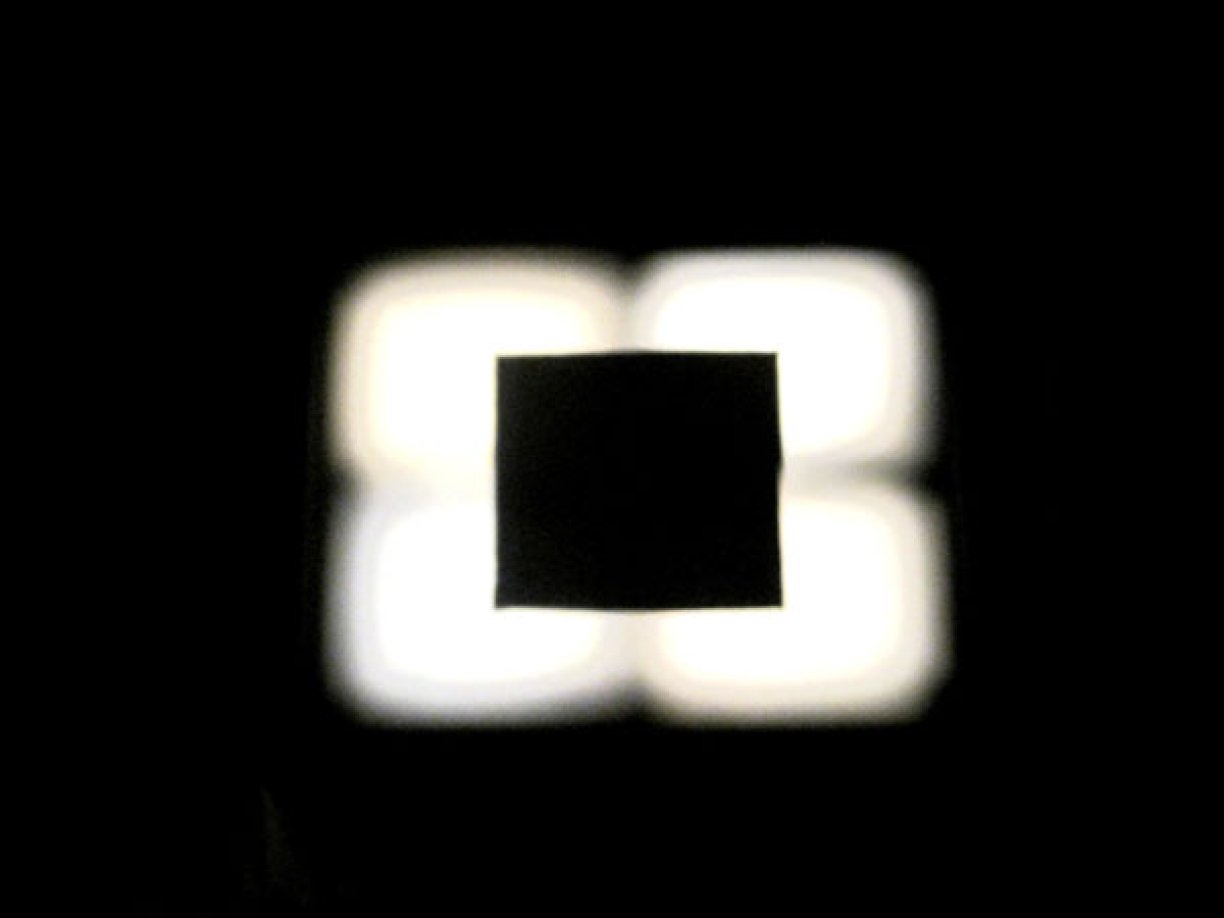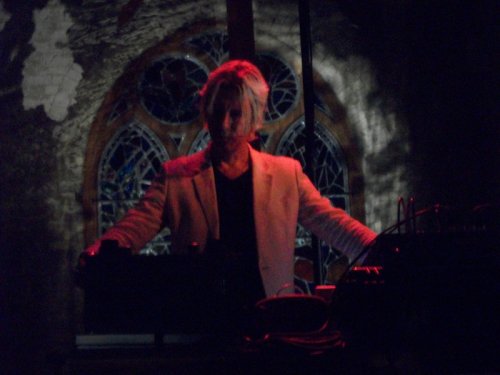Branden Joseph presents a talk regarding "biomusic and the end of representation" with performances by filmmaker Bruce McClure and composer David Dunn.
Producing a totally sensory experience, Bruce McClure’s projector performances are informed by the way the brain reacts to light and sound. Using an array of modified 16mm projectors, film loops, and guitar pedals, his work challenges cinematic conventions. Film loops patterned with patches of emulsion on a translucent base are combined with an optical soundtrack to create a physically intense adventure. His performances have amazed audiences at the Whitney Biennial and the Rotterdam Film Festival, and have garnered him the 2008 Alpert Award in the Arts.
VENTROLIQUENT AGITATOR (2010)
Ventriloquent Agitator is a four projector performance, with each projector modified using variable transformers introduced into the lamp circuits and fitted with identical metal plates rotated 90 degrees and inserted in the film shoe assembly. Each machine is threaded with loops of patterned emulsions consisting of one frame base to five frames of emulsion. Sound originates from the emulsion pattern as an optical sound signal and is processed by guitar effects pedals – metal distortion, delays and equalizers.
BRING IN THE LIGHT PUPPETS! Jointed figures that shadow the screen, still another time but uniquely patterned as zona pellucida, penumbra and umbra making an inscrutable plasma in their elastic envelope. Customarily, projector mechanisms precondition the conjunction of light and shadow while film trims and ornaments it. Outfitted in this manner, projection navigates by a nuance of filmic trim tabs that target expectancy. This performance, however, occasions turbulence by salient agitators that intercede and emancipate the projector and its incandescence from servitude to film’s foreground scenics. Liberal, the agitators are tolerant and work vestiges of film’s hegemony restructuring them on the screen by their metallic intervention into a four square sectorial gestalt. Sound on film, admitted in 1927, is preserved and the constancy of the projector’s unseen binary is celebrated on the photoelectric cell. This miniature theater contains the conditioned reflexes delayed in the wings but patiently awaited but the earmarked assembly poised for ossicular applause. These ventroliquent agitators, mechanical agents, are like arctic explorers amid treacherous regions where one entirely looses the directing compass, since at the pole the needle indifferently respects all points of the horizon alike.
Branden W. Joseph is Frank Gallipoli Professor of Modern and Contemporary art in the Department of Art History and Archaeology at Columbia University. He is the author of Random Order: Robert Rauschenberg and the Neo-Avant-Garde (MIT Press 2003), Anthony McCall: The Solid Light Films and Related Works (ed. Christopher Eamon; Northwestern University Press/Steidl, 2005) and, most recently, Beyond the Dream Syndicate: Tony Conrad and the Arts after Cage (Zone Books, 2008). His writings have also appeared in Artforum, Bookforum, Art Journal, Critical Inquiry, October, Texte zur Kunst, Parkett, and Les Cahiers du Musée national d’art moderne, as well as in such catalogues as CTRL [SPACE]: Rhetorics of Surveillance from Bentham to Big Brother (2002), X-Screen: Film Installations and Actions in the 1960s and 1970s (2003), and Robert Rauschenberg: Combines (2005). He is also a founding editor of Grey Room, a journal of architecture, art, media, and politics, published quarterly by MIT Press since 2000.
"This talk will discuss the emergence and development of the notion and practice of 'biomusic' in the late-1960s and 1970s. At stake was an epistemological shift in the notion of advanced musical practice—from 'experimental music' to what composer Manford L. Eaton termed 'experiential music'—as it was understood to address and impact the intellect and physiology of the listener. At stake was the larger conception of music as a distinct art form, which was understood to cede before an implicitly audiovisual feedback loop that engaged with the real of the body as against the 'imaginary' of (audiovisual) representation and the 'symbolic' domain of the musical score. Ultimately, the notion of biomusic proposed a new vision of the listening subject in line with cybernetic and proto-cybernetic models developing within the post-World War II era."
David Dunn (b.1953, San Diego) is a composer who primarily engages in site-specific interactions or research-oriented activities. Much of his current work is focused upon the development of listening strategies and technologies for environmental sound monitoring in both aesthetic and scientific contexts. Dunn is internationally known for his articulation of frameworks that combine the arts and sciences towards practical environmental activism and problem solving. From 1970 to 1974, he was an assistant to the American composer Harry Partch and remained active as a performer in the Partch ensemble for over a decade. Other mentors included composers Kenneth Gaburo and Pauline Oliveros, in addition to Polish theater director Jerzy Grotowski. He has been the recipient of over 35 grants and fellowships for both artistic and scientific research, including the National Endowment for the Arts, the Rockefeller Foundation, Langlois Foundation, McCune Foundation, Meet the Composer, Ford Foundation, Delle Foundation, Tides Foundation, New Mexico Arts Division, and the US embassies to Argentina and Kyoto, Japan. In 2005, he received the prestigious Alpert Award for music, and the Henry Cowell Award from the American Music Center in 2007. His compositions and soundscape recordings have appeared in over 500 international forums, concerts, broadcasts, and exhibitions.
As a pioneer in the fields of acoustic ecology, bioacoustics, interspecies communication, and scientific sonification, he has composed a body of innovative and experimental musical work and has contributed to projects as diverse as sensory enhancement of healthcare environments, intervention strategies for forest and agricultural pests, reducing sensory deprivation problems in captive animals, and the design of international broadcast networks. He has investigated, among other things, the interrelationship between music and language and the ultrasonic world beyond human hearing. As an expert wildlife recordist, Dunn has invented microphones to record such phenomena as the sounds of bark beetles within trees and underwater invertebrates in freshwater ponds, and the design of self-organizing autonomous sound systems for interaction between artificial and natural non-human systems. As a scientific researcher, Dunn is about to co-file a provisional patent on a device and protocol for control of tree invading invertebrates using acoustic means. Underlying all his work is a common regard for music as a communicative source with a living world.
Ultrasonic Walk 1 (2009)
A few years ago I began to experiment with designs for building ultrasonic microphones that had an omni-directional response and with techniques for translating the resultant recordings into the audible spectrum of humans. Quite recently I have deigned and constructed a binaural version of these microphones capable of preserving the interaural phase and amplitude difference of human hearing after such ultrasonic sounds are slowed and stretched through sample rate conversion into the normal human hearing range. This piece represents a simple 6-minute walk in my backyard in Santa Fe, New Mexico, while wearing the binaural ultrasonic microphones. The sounds consist of small metal and bamboo wind chimes blowing in the wind, wild birds, the sound of my footsteps on dried leaves, and other neighborhood noises. All of the normally audible sounds were filtered out with the remaining high frequency audio component (20kHz to 96kHz) then converted to a new sample rate. This time stretched recording was then edited into the original source recording duration. No other signal processing was used. Only the original inaudible sound component remains but is now heard in entirely new time and frequency domains.
Thresholds and Fragile States (2010)
This live performance uses a one-of-a-kind set of non-linear chaotic oscillators capable of generating an infinite variety of “auditory behaviors” emergent from their status as autonomous electronic systems. Based upon the theory of “biological autonomy” and new principles in cognitive science, these circuits represent an alternative design philosophy for the creation of electronic sound synthesis. More akin to living systems than information processing devices, these circuits produce a dazzling assortment of complex noises andany sounds produced by the circuits emerge as a type of “conversation” that exhibits repetitive action at a local level but tremendous global diversity over extended time periods. In this sense the circuits resemble the closed nervous systems of living unities that are under constant perturbation from other similar closed nervous systems. The intention is not to simulate the high level functioning of biological organisms and their cognitive capacities but rather to take this question down to its most primary level of autonomous-closure machines where self-organization is more obviously inseparable from behavior. Ultimately the emergent complexity of these systems results from the dynamical attributes of coupled chaotic attractors interacting in a high dimensional phase space. The control of circuit parameters determines a range of instabilities and structural couplings between nested chaotic circuits, allowing these autonomous behaviors to emerge.
...with zitterings of flight released (in memoriam Kenneth Gaburo) (1993)


